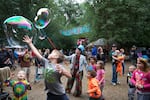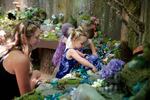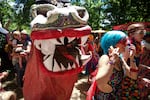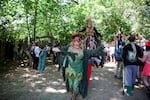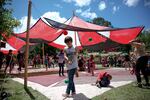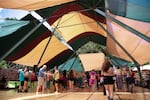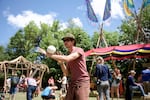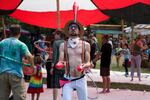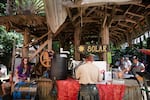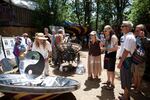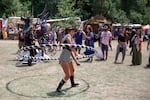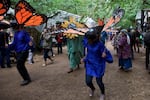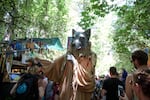
Giant puppets are one of the many sights to see at the Oregon Country Fair during July 8-10 in Veneta, Oregon.
Shirley Chan / OPB
If the dream of the '90s is alive in Portland, then every July the dream of the late '60s dusts off the cosmic cobwebs and gives peace, love and harmony another whirl in Veneta, Oregon.
Held on 446 acres of forested land along the Long Tom River, the Oregon Country Fair is more than an annual gathering — it is, for some, a family tradition that spans decades.
“I’m 24 and have been going for 25 years,” said Rey Rudak, who works at Get Fried Rice, one of the 75 food booths that set up at the festival. “I was a womb baby. My dad has been going since before I was born, for over 30 years.”
Started in 1969 to raise funds for an alternative school, what was once known as Oregon Renaissance Fair has stayed true to its philanthropic and educational roots. It has also kept the spirit of 1960s counterculture movement alive. The three-day event focuses on family-friendly entertainment, community gathering and artistic self-expression. On any given day during the festival, giant puppets, costumed revelers and modern-day minstrels mingle with attendees and vendors under a leafy canopy.
“It’s a party with a purpose,” said Charlie Ruff, the former general manager of the fair. “We’re here to set an example of how the world could look differently.”
In attending the fair, younger generations get a taste of the late '60s and early '70s, a formative time for their parents. They are also helping to influence the direction of the fair by bringing to it their own experiences.
“I’ve seen a progression towards it become more of an elders’ festival as people who created the fair,” Rudak said. “As they get older, they want it to be what they want it to be when they were young.”
“We have this mix of old and new — of formally rooted and new stalks,” Ruff said. There are now more than 1,000 "elders," and Tom Gannon, the fair’s new general manager, finds it more important than ever to support this group. He hopes to see the older generation pass on institutional knowledge to younger festival-goers, many of whom he has already seen step into leadership roles.
“These kids are growing up,” Rudak said. “They want to do what their parents do.”
Gannon is “making strides to engage that next generation.” Having an administrative background previously working for Seattle Public Utilities, he hopes to involve the community more in the fair’s planning process.
“I really hope the fair looks different 30 years from now than 20 years ago,” Ruff said. As the fair grows, he hopes traditions live on while transitioning into a new generation. The fair remains a grassroots movement with thousands of workers in the fair family keeping it alive.
“The feeling that we get — it’s freeing,” Rudak said. “You’re able to dance around, be who you want to be, no one judging. You’re able to let loose, do what you want to do and have as much as fun as you want.”
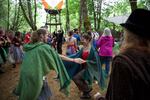
The 18 stages at the fair provide many opportunities for visitors to dance under the canopied woods.
Shirley Chan / OPB
“It should be on everyone’s bucket list,” Gannon said, “nothing else is like it.”
The Oregon Country Fair is held 13 miles west of Eugene the second weekend in July. This year's festival takes place July 8–10.
